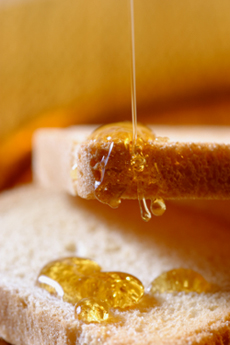TIP OF THE DAY: How To Fix Crystallized Honey
|
Like most foodstuffs, honey does best in a location that is cool and dry. Store honey at room temperature, away from direct sunlight. Never put honey in the fridge; it accelerates the crystallization.* When honey crystallizes, the texture becomes “crunchy”—not a pleasant state for most people, but still safe to eat. Crystallization is a natural process that occurs when glucose, one of three main sugars in honey (along with fructose and sucrose), spontaneously precipitates out of the supersaturated† honey solution and takes the form of crystals. All honey will ultimately turn to sugar crystals—some in months, some not for years. * Other terms for crystallization include sugared, granulated, solidified and crystallized. The crystals may be large or small, grainy/sandy or smooth. †The supersaturated state occurs because there is so much sugar in honey (more than 70%) relative to the water content (often less than 20%). |
 It’s pouring freely now, but what can you do when it crystallizes? Photo by Vaskoni | IST. |
|
|
How To Fix Crystallized Honey Simply place the honey jar in a microwave-safe container with the lid off, and microwave it for 30 seconds. Plastic containers may not be microwaveable, so transfer the honey to a microwave-safe receptacle (we use a Pyrex measuring cup with an easy-pour lip) and then return the honey to the container. Another tip: spray the measuring cup or dish with cooking spray so the honey will flow back into its container more easily. If you don’t have a microwave, you can place the jar in hot water and stir occasionally until the crystals dissolve, about 10 to 15 minutes. How To Keep Honey From Crystallizing ‡ Processing removes grains of pollen and extraneous solids. The process typically heats honey to 150°F to 170°F. |
||